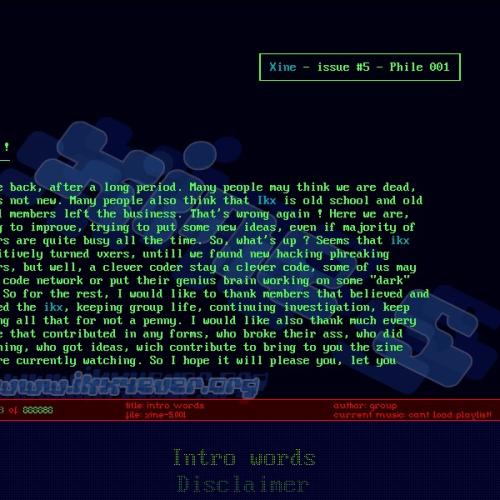Copy Link
Add to Bookmark
Report
Anada 027

* * * * * * * *
A A N N A A D D A A
A A N N N A A D D A A
A A N N N A A D D A A
A *** A N N A *** A D D A *** A
A A N N A A D D A A
A ****************************** A
A "Jaisini" aNAda #27 A
A A
A by Yustas Kotz-Gottlieb 03/19/00 A
A A
********************************************************************
**Editor's note: This file has an interesting story. Apparently, this guy,
Mr. Kotz-Gottlieb ("Gottlieb" meaning 'God-love' in German), has been
mass-spamming art websites, guestbooks, e-mails, and newsgroups with his
attempt to spread the word of fine art to the masses. And it is with
great pleasure that aNAda was sent one of his letters, and it is with even
more pleasure for us to post it here today. Yes.
{*****}
I am Yustas Kotz-Gottlieb, a writer in New York. I work on a book
about Gleitzeit art by Jaisini.
This action is on behalf of Gleitzeit - art - Jaisini movement to
bring high aesthetics closer to people.
Thank you.
Yustas Kotz-Gottlieb
{*****}
Jaisini
Manifesto
(short version)
Gleitzeit
Gleitzeit style based on depiction of visual flexibility with
theoretical flexibility.
A painting which purpose is to achieve composition of enclosure.
Art based on the depiction of a circle evolution of understanding and
seeing.
A kind of art which draws upon imagery and seeks to reveal and
abstract idea of the connection within.
It's flexible because it has multiple principles.
Paintings with a capacity to change visually by the artistic magic
changing your subconscious mind.
It is a session of Hypnosis which controls you by a disorganized
absolute harmony of everything expected from a "nonexistent" picture.
It depends upon the pattern of line as a primal creator of whatever
associated or disassociated from the theme.
The artist's mind is the superior beginning of the line, but the line
is free and emancipated.
Flexi is a new neo-pro-anti-post
{*****}
Pinocchio
(Oil painting by Jaisini)
Jaisini, an artist of a new time and age, looks at the traditional
art concerns of good and evil in a wider perspective. As we all know, this
used to be a standard Biblical subject for the artist's exploration of the
two sides of human nature.
In Pinocchio, Jaisini introduces the performance of late modern
critical nature. It is a moralizing representation which is open to
interpretation. Little in Jaisini's art is straightforward representation.
Most elements are open to variety of interpretations, though a presence of
devil in Pinocchio brings us closer to the original concern.
As we know, from the history of art, in the art works of medieval
times, especially in the paintings of Bosch, devils appear among people
during their ordinary working lives. It epitomized the medieval belief in
the real unseen existence of demons and devils everywhere.
For Jaisini it may be a simplest message of the ever-present
antagonist to the human corrupt nature. The pictorial language of the
artist is based on his search for the unusual associations. Here, Jaisini
has produced a remarkably dramatic evocation of a turmoil at the party
table. The idea of Pinocchio may be the Bosch's type illustration of the
body prevalence over spirit. Jaisini does not show tormenting but a more
contemporary kind of punishment as a birth of a black child with a knife.
His white mother is covered with table cum-stained cloth. When the true
image of the childbirth is revealed, the shock tactic invades the space.
The orgy itself, the table and under the table seem like a replay of a crime
scene.
The giving birth mother exposes the unattractive site of birth. Her
privacy is violated as she is a participant of the table orgy it seems like
some distant laughter echoed evilly in her attempt to give birth to that
violent child with the knife that cannot yet kill but targets surrounding
world with it's pirate like curve. In Pinocchio the gap between the hard,
prosaic reality grows more and more and the dreamy flexireality may be able
to reflex more truthfully contemporary life with it's complexity. No court
of law yet defined the art guilty of such reflection of unwanted truth,
mimicking the facts of physical world in connection of unlikely situations
and less expected interpretations. In the Pinocchio the puppeteer behind
the staged performance of the orgy is supposed to be the author of the
painting, but is he? The artist seems to be a mediator of social sadistic
fantasies who entered them through artistic mode on the canvas with almost
childish frivolity but with serious impact. In his works the heroes are
freed from the burden of the gendered flesh being puppets at the same table
with people and creatures of superpower or animals. The works like
Pinocchio, 911, Meat Grinder have some posttraumatic content of the world in
a process of loosing emotional content with its murderous rage and maniac
annoyance of speeded change.
The orgy which takes place at the table and under it could symbolize
the notion of an 'absolute democracy.' To the artist that is satirical,
cynical, and tragic all at the same time, 'the most shameless thing.'
Jaisini shows a committee of three at the same festive table where two are
absent. The ruler is introduced by the liar Pinocchio. The birds symbolize
politicians whom artist saw as representatives of the evils inherent in the
legal and political machinery.
By arranging the partitions of the bodies by the table cloth, which
covers and opens bodies portions, Jaisini lends an erotic dimension to the
somber, grisaille color of the painting. The effect of sobriety, the
controlled orgy, not a temperamental and eager as in Hot Dog Party, but
rather dead is achieved here. It seems that the table cloth demarcates two
realities, which are not that different from each other, with the same signs
of sinnery, evoking man's abstruse appetite for 'bad.'
The table cloth opens a view that an aphorism describes well: "the
only truths which are universal are those gross enough to be thought so."
Jaisini doesn't adopt both, reality or unreal. He allows his works
to receive different interpretations and to continue offering a mystery. A
super plasticity and integration in Jaisini's work sketch out a new
cosmology with the senses translated into visual terms.
The 'table' composition in Pinocchio, Hot Dog Party, Barbie Q, and so
on, creates a phenomenological experience of space. Some things are
effective and eternally magnetic. Jaisini as an alchemist, searches for a
philosopher's stone which can transmute base metals into gold. He canonizes
the technique of his enclosed composition of a secluded line together with
the continuous idea, almost a myth, a riddle, a fascinating concept, the
artist creates a new reality, fully integrated, with its own laws and
reasons for existence.
` The choice of images like Pinocchio, which are grotesque, brings the
image to a new universal meaning. The clowns and fools are the
representatives of the carnival spirit in the everyday life. In the Bosch's
"Ship of Fools' the scene is presided over by a jester fool, whose role is
to satirize the morals and manners of the day. Fools posses the
time-honored privilege to be other in this world, the right to be in life
but not of it, the right to confuse, to tease, to act life as a comedy and
to treat others as actors.
Jaisini's style is marked by theatrical whimsicalism. His use of
fools in some works could hold the artist's hope for humanity, hope that
life is not necessarily predetermined towards loss, failure, and
catastrophe. To the contrary, the artists like Bosch believed that sins of
humankind are endemic and that hell is our ultimate destiny.
Jaisini creates in a carnivalesque tone his Show Time, Talk Show, Hot
Dog Party. Barbie Q, Lunch Time, Sinphony, etc., which reflects the current
condition of historical development when life becomes a permanent mixed
eruption of excitement, spectacle, happiness, joy, tragedy, loss, conflict,
dilemma, terror, and death. Still, human destiny is conceived as open or at
least as not finally tragic and not predetermined to failure, but can change
and transform. The artist gets his impetus and irrepressible energy to
create in sometimes carnivalesque tone, as a social critique, nonetheless
serious for being theatrical, extravagant, and playful. Carnivalesque may
remain an always dangerous supplement, chellenging destabilizing,
revitalizing, pluralising single notions of true culture, true reason, true
art.
by Yustas Kotz-Gottlieb
"Pinocchio" (Oil painting) by Paul Jaisini,
New York 2000, Text Copyright;Yustas Kotz-Gottlieb
ALL RIGHTS RESERVED
Writings:
Talk Show
Marble Lady
Hot Dog Party
Pinocchio
Drunken Santa
Manifesto
{**************************************************************************}
{ (c)2000 aNAda e'zine * * aNAda027 * by Yustas Kotz-Gottlieb }
**************************************************************************






















